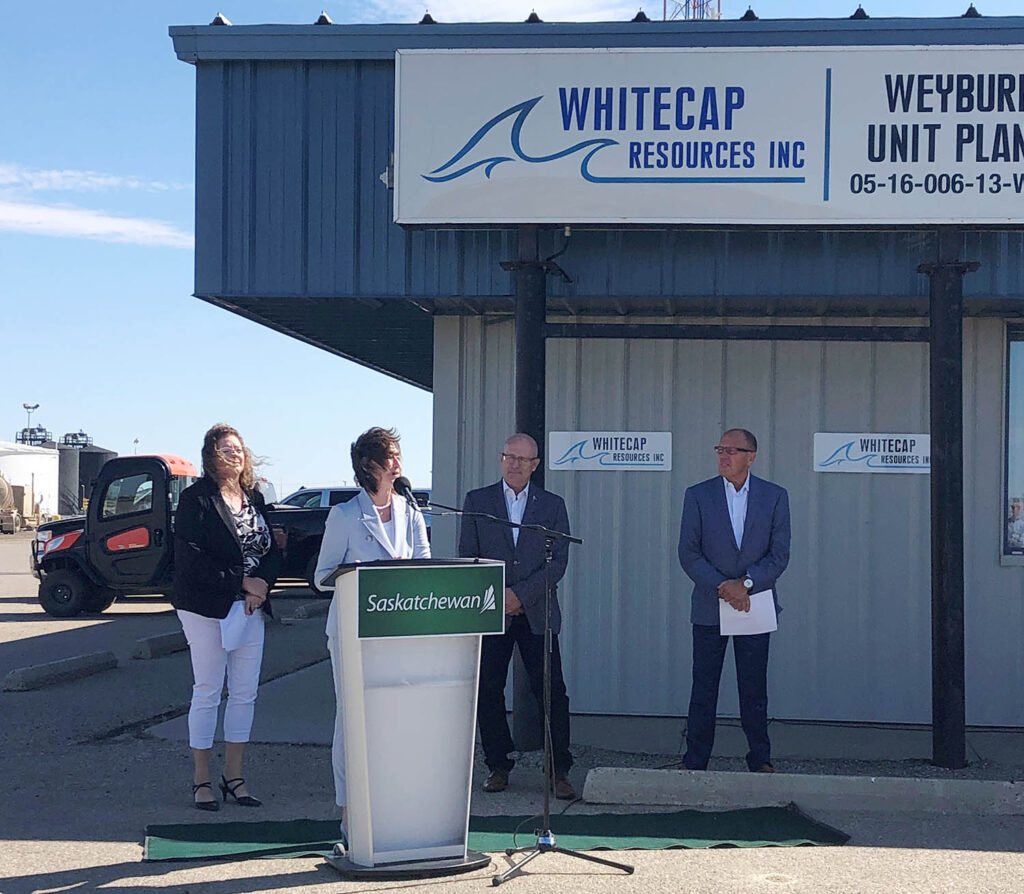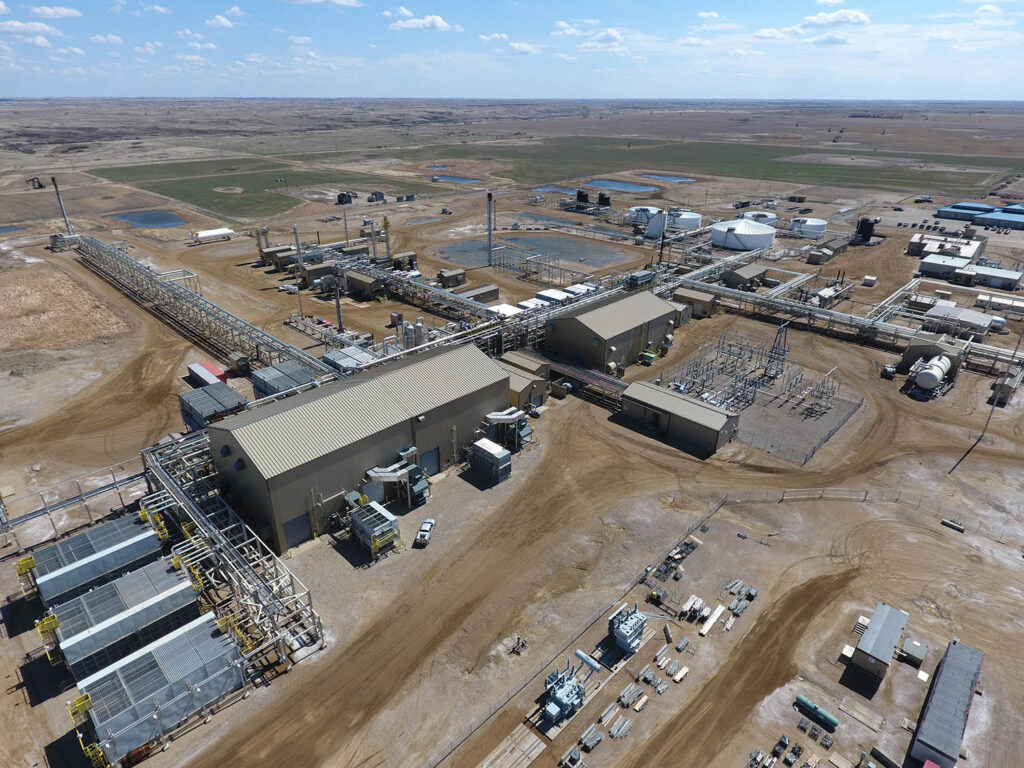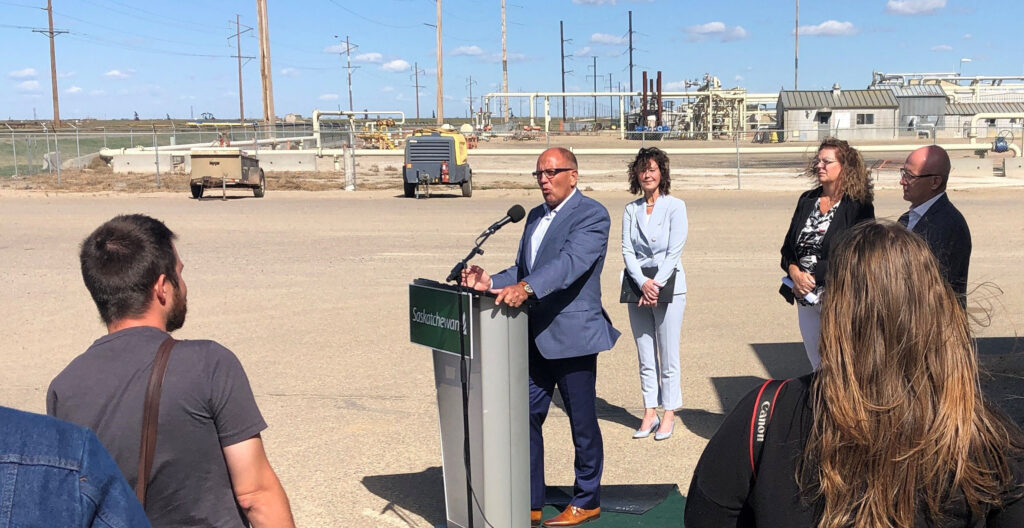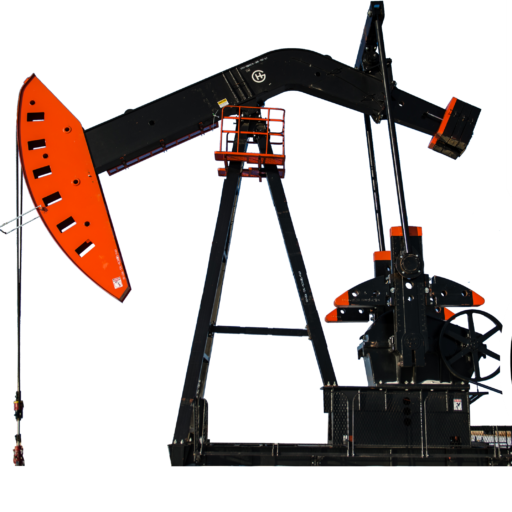Brian Zinchuk is editor and owner of Pipeline Online
WEYBURN – Saskatchewan hasn’t given up on carbon capture, utilization and storage (CCUS). Far from it, as its Energy and Resources Minister Bronwyn Eyre announced on Sept. 7 the government’s strategies to further develop its implementation throughout the province. That announcement laid the foundation for what could result in not one, but multiple carbon capture hubs, and their implementation.
But the key part is the additional letter, the U in CCUS. The Saskatchewan government sees the future in utilization through enhanced oil recovery (EOR), something they say the federal Liberal government is essentially turning a blind eye to. And if Saskatchewan is successful, it could lead to multiple billion dollar projects and millions of tonnes of carbon dioxide captured and stored each year.
Thus, it was no coincidence that the announcement on Sept. 7 was held at the Whitecap Resources Weyburn Unit, which has been using captured carbon dioxide and utilizing it for enhanced oil recovery ever since 2000.
Eyre said by phone after the announcement, “It’s about getting ahead of the narrative. We’re hearing so much about CCUS now, and Saskatchewan has been doing it for a long time, particularly around EOR. I think it’s important we stand strong behind EOR CCS. There are a million good reasons why enhanced oil recovery with CO2 has 82 per cent less emissions than conventional method extractions. That’s a great win when we’re talking about environment and the economy.”

Saskatchewan Minister of Energy and Resources Bronwyn Eyre spoke at the Whitecap Resources-operated Weyburn Unit on Sept. 7. Photo by Darcy Cretin/Whitecap Resources
The announcement was made two weeks before the federal election, and that wasn’t a coincidence. Eyre would like to see the federal government put in place a federal tax credit that would encompass the enhanced oil recovery-carbon capture, utilization and storage, not just CCUS.
“So we’re going to look in terms of what the province can do. We’re going to look to expand the infrastructure investment incentive, as you saw, that was introduced March 2020. It was obviously for pipeline infrastructure primarily, but this would include the CO2 pipeline trunk lines.”
The concept of these “hubs” is similar to what Alberta has built in the Edmonton region – the Alberta Carbon Trunk Line. Captured carbon dioxide from multiple sources is pumped into the line, and downstream, it is used for enhanced oil recovery.
- 0098 SASPO-2874_Self Serve Campaign_New Connects_Youtube_v30098 SASPO-2874_Self Serve Campaign_New Connects_Youtube_v3
- 0100 Turnbull Project Manager0100 Turnbull Project Manager
- 0099 Mryglod Steel 1080p0099 Mryglod Steel 1080p
- 0097 Eagle Sky Ventures LTD0097 Eagle Sky Ventures LTD
- 0095 Fast Trucking nearly 70 years good at it0095 Fast Trucking nearly 70 years good at it
- 0053 Kingston Midstream Westspur Alameda Click Before You Dig0053 Kingston Midstream Westspur Alameda Click Before You Dig
- 0092 Turnbull projects big and small0092 Turnbull projects big and small
- 0046 City of Estevan This is Estevan Teaser0046 City of Estevan This is Estevan Teaser
- 0087 Lori Carr Coal Expansion0087 Lori Carr Coal Expansion
- 0077 Caprice Resources Stand Up For Free Speech0077 Caprice Resources Stand Up For Free Speech
- 0076 Latus only0076 Latus only
- 0061 SIMSA 2024 For Sask Buy Sask0061 SIMSA 2024 For Sask Buy Sask
- 0055 Smart Power Be Smart with your Power office0055 Smart Power Be Smart with your Power office
- 0051 JML Hiring Pumpjack assembly0051 JML Hiring Pumpjack assembly
- 0049 Scotsburn Dental soft guitar0049 Scotsburn Dental soft guitar
- 0041 DEEP Since 2018 now we are going to build0041 DEEP Since 2018 now we are going to build
- 0032 IWS Summer hiring rock trailer music
- 0022 Grimes winter hiring
- 0021 OSY Rentals S8 Promo
- 0018 IWS Hiring Royal Summer
- 0013 Panther Drilling PO ad 03 top drive rigs
- 0006 JK Junior
- 0002 gilliss casing services0002 gilliss casing services
- 9002 Pipeline Online 30 sec EBEX9002 Pipeline Online 30 sec EBEX
- 9001
Is the Saskatchewan government laying the groundwork for a Saskatchewan carbon dioxide trunk line, similar to what Alberta has done?
Eyre said, “In terms of those hubs, that’s what it would largely be.
“Certainly, in terms of the investment incentives, the infrastructure investment incentive, that, I think, is a necessary part of what you’re talking about.
“I think that’s a very helpful, pragmatic way of bringing that CO2 infrastructure under that infrastructure umbrella.”
Trunk lines and centralized areas, with numerous facilities tied into them, with economies of scale, are what Eyre envisions. There are some pretty significant unknowns around what federal support will look like, because capital costs would also be significant. Whitecap Resources president and CEO Grant Fagerheim explained that costs for each carbon capture project could be around $1 billion, and there could be multiple capture projects.
Saskatchewan has several clustered industrial facilities with large volumes of carbon dioxide emissions. CO2 capture can either be directly injected underground for permanent storage or it can be used for enhanced oil recovery and subsequent permanent storage; both options can be an expensive on an individual facility basis. Potentially, large industrial facilities in a region can work together to form CO2 capture hubs to bring economies of scale by allowing companies to share infrastructure. Hubs for collecting and transporting CO2 from multiple sources can provide utilization projects, like CO2 EOR, with a reliable source of CO2, as well as give industrial capture facilities reassurance that they will have a long-term destination for permanent storage of their CO2. Preliminary analysis has identified potential hubs of large CO2 emitters in the Regina-Moose Jaw and Greater Lloydminster areas. While these areas indicate the presence of significant clustered CO2 emissions, further analysis is required to confirm economic feasibility.
The Government of Saskatchewan is also exploring models and instances, in addition to hubs, where it may be more feasible and efficient for companies to capture and transport CO2 directly to oil producers for EOR and permanent storage purposes without necessarily going through a centralized infrastructure hub.
Eyre said, “We want to make sure that we say we’re open to this. We’ve talked to the feds. We urged them to do this and help us on the hub thing.”

The Weyburn Unit central battery could be the end point for a carbon trunk line that could run from Bethune to Moose Jaw, Regina, and Estevan. Photo by Brian Zinchuk
To that end, Saskatchewan’s strategy will see the government work with the energy sector to evaluate the EOR royalty regime to ensure that CO2 injection projects remain highly competitive.
It will amend and clarify regulations to support investment and provide certainty around pore space ownership, access, unitization of high-potential EOR plays, and long-term obligations and accountability for CO2 storage.
A carbon trunk line for the Regina region, and a second one in the Lloydminster region, are key considerations. The release noted the government would, “Explore opportunities for CCUS infrastructure hubs and distribution models, including for the Regina- Moose Jaw Industrial Corridor to Southeast Saskatchewan and Greater Lloydminster areas.”
To make the financial aspect work the government would “advance the development of a CCUS greenhouse gas credit generation program, recognized under Saskatchewan’s emissions management framework, focused on predictability and minimal administrative burden for industry prior to investment and the maximization of credit generation for captured and sequestered CO2.”
- 0098 SASPO-2874_Self Serve Campaign_New Connects_Youtube_v30098 SASPO-2874_Self Serve Campaign_New Connects_Youtube_v3
- 0100 Turnbull Project Manager0100 Turnbull Project Manager
- 0099 Mryglod Steel 1080p0099 Mryglod Steel 1080p
- 0097 Eagle Sky Ventures LTD0097 Eagle Sky Ventures LTD
- 0095 Fast Trucking nearly 70 years good at it0095 Fast Trucking nearly 70 years good at it
- 0053 Kingston Midstream Westspur Alameda Click Before You Dig0053 Kingston Midstream Westspur Alameda Click Before You Dig
- 0092 Turnbull projects big and small0092 Turnbull projects big and small
- 0046 City of Estevan This is Estevan Teaser0046 City of Estevan This is Estevan Teaser
- 0087 Lori Carr Coal Expansion0087 Lori Carr Coal Expansion
- 0077 Caprice Resources Stand Up For Free Speech0077 Caprice Resources Stand Up For Free Speech
- 0076 Latus only0076 Latus only
- 0061 SIMSA 2024 For Sask Buy Sask0061 SIMSA 2024 For Sask Buy Sask
- 0055 Smart Power Be Smart with your Power office0055 Smart Power Be Smart with your Power office
- 0051 JML Hiring Pumpjack assembly0051 JML Hiring Pumpjack assembly
- 0049 Scotsburn Dental soft guitar0049 Scotsburn Dental soft guitar
- 0041 DEEP Since 2018 now we are going to build0041 DEEP Since 2018 now we are going to build
- 0032 IWS Summer hiring rock trailer music
- 0022 Grimes winter hiring
- 0021 OSY Rentals S8 Promo
- 0018 IWS Hiring Royal Summer
- 0013 Panther Drilling PO ad 03 top drive rigs
- 0006 JK Junior
- 0002 gilliss casing services0002 gilliss casing services
- 9002 Pipeline Online 30 sec EBEX9002 Pipeline Online 30 sec EBEX
- 9001
That would make everything up to date on the regulation front and on the royalty front, according to Eyre. She said, “We want to continue to press the feds to put their money where their mouth is on the CCUS hubs, and the capital required there. They’ve called us a ‘world leader,’ or ‘poised to be a world leader,’ on that front. So again, if we’re going to go with hubs, now, they certainly come with a cost.”
Eyre said the provincial government wanted to get awareness of what those hubs could look like, and what they might be.
She noted there could be one in central Saskatchewan that would encompass the Bethune Mine, Mosaic, Moose Jaw Refinery and Regina Co-op Refinery. “There’s a lot of potential there,” Eyre said.
Additionally, there could be a hub in Saskatchewan’s northwest, in the Lloydminster region, which could possibly work with Alberta. “I think there are lot of exciting projects on the horizon around EOR-CCUS, really exciting stuff,” she said.
Boundary Dam Unit 6
Eyre referenced the possibilities of retrofitting Boundary Dam Power Station Unit 6 and Shand Power Station with carbon capture. While SaskPower opened the Boundary Dam Unit 3 Integrated Carbon Capture and Storage Project in 2014, in more recent years, the Crown corporation decided not to implement carbon capture on Units 4 and 5, both of which will be retired in the next few years.
Scale has previously been noted by SaskPower as an issue, as Units 3,4 and 5 were all 150 megawatt units, while Unit 6 and Shand are referred to as 300 megawatt units.
Without a carbon capture retrofit for Unit 6 allowing it to operate beyond 2030, the Boundary Dam Power Station, which once produced over 1,000 megawatts with six generating units, would be reduced to producing roughly 125 megawatts with just Unit 3. If Shand Power Station is forced to close by 2030 as well, there would be just one, relatively small coal-fired power unit, Unit 3, remaining.
Eyre said they are “putting that to the feds, as retrofitting those would be very costly. And so, we do need to kind of work together, if they’re serious.”
The Unit 3 carbon capture project had received $240 million in federal funding, announced in 2008 by Prime Minister Stephen Harper. It eventually cost $1.6 billion after cost overruns were included. Much of those cost overruns were associated with the refurbishment of the old power station’s facilities, including asbestos abatement.
In recent years, discussion about further carbon capture and storage with SaskPower largely focused on the Shand Power Station. Eyre’s reference to Boundary Dam Unit 6 is one of the first to be made in public in recent years.
Asked if that was still in the cards, Eyre said, “That’s what we asked the feds to do, to help us with that capital retrofitting of BD 6, again, to enable CCUS. That is very costly.
“If they’re interested, as they say they are, in the whole sequestration, hub, etc. model, then they could help us with that. So yes, it is still in the works, as far as looking at options around BD 6 and Shand, potentially.”
Shand
The press release noted, “The Government of Saskatchewan anticipates that CCUS projects will attract provincial investment of more than $2 billion and sequester over two million tonnes of CO2 annually.”
That reads very closely like the recent feasibility study into implementing carbon capture at Shand, released by the International CCS Knowledge Centre. Their website notes, “The Shand CCS project design capacity is nominally two million tonnes of CO2 captured per year — twice the initial design capacity of BD3 (this economy of scale reduces costs)”
Asked if this is what the province is referring to, Eyre responded, “That may be, but that number is not based solely around Shand. It’s based on where we see some of the projects that we understand are being developed by, among others, oil companies, in terms of synergies and partnerships and collaborations that they feel are strong potential. And some of them are very, very innovative.
“If anything, it’s laying the groundwork for all of the above, really.”
She said Shand is one that was raised with the federal government on the CCUS side of things.
Retrofitting the Poplar River Power Station at Coronach have not been formally asked of the federal government, according to Eyre.
- 0098 SASPO-2874_Self Serve Campaign_New Connects_Youtube_v30098 SASPO-2874_Self Serve Campaign_New Connects_Youtube_v3
- 0100 Turnbull Project Manager0100 Turnbull Project Manager
- 0099 Mryglod Steel 1080p0099 Mryglod Steel 1080p
- 0097 Eagle Sky Ventures LTD0097 Eagle Sky Ventures LTD
- 0095 Fast Trucking nearly 70 years good at it0095 Fast Trucking nearly 70 years good at it
- 0053 Kingston Midstream Westspur Alameda Click Before You Dig0053 Kingston Midstream Westspur Alameda Click Before You Dig
- 0092 Turnbull projects big and small0092 Turnbull projects big and small
- 0046 City of Estevan This is Estevan Teaser0046 City of Estevan This is Estevan Teaser
- 0087 Lori Carr Coal Expansion0087 Lori Carr Coal Expansion
- 0077 Caprice Resources Stand Up For Free Speech0077 Caprice Resources Stand Up For Free Speech
- 0076 Latus only0076 Latus only
- 0061 SIMSA 2024 For Sask Buy Sask0061 SIMSA 2024 For Sask Buy Sask
- 0055 Smart Power Be Smart with your Power office0055 Smart Power Be Smart with your Power office
- 0051 JML Hiring Pumpjack assembly0051 JML Hiring Pumpjack assembly
- 0049 Scotsburn Dental soft guitar0049 Scotsburn Dental soft guitar
- 0041 DEEP Since 2018 now we are going to build0041 DEEP Since 2018 now we are going to build
- 0032 IWS Summer hiring rock trailer music
- 0022 Grimes winter hiring
- 0021 OSY Rentals S8 Promo
- 0018 IWS Hiring Royal Summer
- 0013 Panther Drilling PO ad 03 top drive rigs
- 0006 JK Junior
- 0002 gilliss casing services0002 gilliss casing services
- 9002 Pipeline Online 30 sec EBEX9002 Pipeline Online 30 sec EBEX
- 9001
Small modular reactors
Eyre said as the province works towards a transition to small modular reactors, or other technologies due to the federally mandated coal exit, the province is asking for help on the capital cost on carbon capture retrofits as we work towards that. While we are mandated to get out of coal in the long term, doing CCUS in the meantime could result in wins in the targets the federal government has set, and mandated the province to do.
The other end of the pipe
The choice of making the announcement at the Whitecap Resources-operated Weyburn Unit spoke to what happens at the other end of the pipe, after carbon dioxide has been captured. Asked about that, Eyre said, “Whitecap has some pretty innovative things that they’re looking at. And as I say, not only Whitecap, but a number of companies.”

From left, Whitecap Resources president and CEO Grant Fagerheim was joined by Energy and Resources Minister Bronwyn Eyre, Minister of Social Services Lori Carr and Minister of Environment Warren Kaeding in announcing Saskatchewan’s movement towards substantially more carbon capture, utilization and storage. A key component would be the federal government allowing for carbon tax input credits. Photo courtesy Darcy Cretin/Whitecap Resources
She pointed out the Weyburn facility is responsible for half of the four million tonnes of CO2 sequestered in Canada each year. “That’s pretty amazing.”
Despite all this, she said the federal government is not interested in enhanced oil recovery.
The announcement was made during the election. With a new parliament almost identical in makeup to the previous one, including a return of the federal Liberal government, the province is essentially where it started.
EOR to be excluded
Eyre said the federal tax credit explicitly said it would not include enhanced oil recovery. She hopes that tax credit will include EOR.
“Now, if you don’t like oil so much, you don’t even like to say it, you know, use it in the term ‘natural recovery,’ and therefore you’re blind to all the environmental benefits to it, I guess I don’t know what to say. I guess you can only remain hopeful that, that they will, perhaps change their mind.”
“Even the federal liberals have said, as they did the budget this last March, that Saskatchewan is poised to become a world leader when it comes to CCUS hubs. So that’s good, that’s positive. We can build on that.”
“If it is the same government, they were going to finalize their CCS strategy by the end of the year. It’s just, I think, really helpful, or I hope helpful, to get our story on the record ahead of that,” she said.
Eyre finds it heartbreaking that the United States, which has enacted a carbon dioxide tax credit known as 45Q, and Canada has not done the same.
“We have to do something like 45Q. The feds had the opportunity, and left out the EOR part. It has changed everything south of us.”
She pointed out that we’re already world leaders, having done this at Weyburn and Midale for more than 20 years.
Editor’s note: Pipeline Online will strive to provide the depth in energy coverage that other media in Saskatchewan simply do not do. In addition to this story, we have one with Whitecap Resources president and CEO Grant Fagerheim, as well as a column explaining its implications. For comparison, here’s the same story as covered by CTV Regina, Leader-Post, and SaskToday.ca. And here’s the original press release.
Launched Oct. 4, Pipeline Online is Saskatchewan’s Energy News. You can find it at PipelineOnline.ca, on LinkedIn., Facebook and Twitter.
- 0098 SASPO-2874_Self Serve Campaign_New Connects_Youtube_v30098 SASPO-2874_Self Serve Campaign_New Connects_Youtube_v3
- 0100 Turnbull Project Manager0100 Turnbull Project Manager
- 0099 Mryglod Steel 1080p0099 Mryglod Steel 1080p
- 0097 Eagle Sky Ventures LTD0097 Eagle Sky Ventures LTD
- 0095 Fast Trucking nearly 70 years good at it0095 Fast Trucking nearly 70 years good at it
- 0053 Kingston Midstream Westspur Alameda Click Before You Dig0053 Kingston Midstream Westspur Alameda Click Before You Dig
- 0092 Turnbull projects big and small0092 Turnbull projects big and small
- 0046 City of Estevan This is Estevan Teaser0046 City of Estevan This is Estevan Teaser
- 0087 Lori Carr Coal Expansion0087 Lori Carr Coal Expansion
- 0077 Caprice Resources Stand Up For Free Speech0077 Caprice Resources Stand Up For Free Speech
- 0076 Latus only0076 Latus only
- 0061 SIMSA 2024 For Sask Buy Sask0061 SIMSA 2024 For Sask Buy Sask
- 0055 Smart Power Be Smart with your Power office0055 Smart Power Be Smart with your Power office
- 0051 JML Hiring Pumpjack assembly0051 JML Hiring Pumpjack assembly
- 0049 Scotsburn Dental soft guitar0049 Scotsburn Dental soft guitar
- 0041 DEEP Since 2018 now we are going to build0041 DEEP Since 2018 now we are going to build
- 0032 IWS Summer hiring rock trailer music
- 0022 Grimes winter hiring
- 0021 OSY Rentals S8 Promo
- 0018 IWS Hiring Royal Summer
- 0013 Panther Drilling PO ad 03 top drive rigs
- 0006 JK Junior
- 0002 gilliss casing services0002 gilliss casing services
- 9002 Pipeline Online 30 sec EBEX9002 Pipeline Online 30 sec EBEX
- 9001
